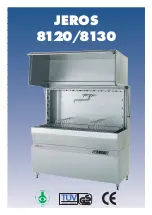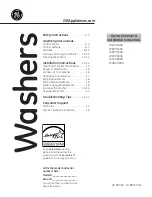
21
Washer leaks
■
Are the fill hoses tight?
■
Are the fill hose washers properly seated?
Check both ends of each hose. See “Connect the Inlet
Hoses.”
■
Did you pull the drain hose from the washer cabinet and
install it in a standpipe or laundry tub?
The drain hose should be pulled from the washer cabinet and
secured to the drainpipe or laundry tub. See “Connect Drain
Hose” and “Secure the Drain Hose.”
■
Is the sink or drain clogged?
Sink and drainpipe must be able to carry away 17 gal. (64 L)
of water per minute. If sink or drainpipe is clogged or slow,
water can back up out of drainpipe or sink.
■
Is water splashing off the tub ring or the load?
The wash load should be balanced and not overloaded. If the
wash load is unbalanced or overloaded, incoming water can
deflect off the load.
■
Is the washer properly installed?
The washer must be level. The feet should be properly
installed and the nuts tightened. See “Level the Washer.”
■
Was the cycle interrupted and then the Deep Clean option
selected?
The Deep Clean option should be started on a dry load only.
The Deep Clean option should not be selected after the tub
has started filling with water.
■
Did you select Deep Clean option and use a hand-
washing detergent?
Regular or hand-washing detergents are not recommended
for this washer. Use only High Efficiency (“HE”) detergent.
■
Check household plumbing (laundry tubs, faucets,
drainpipe, water pipes) for leaks.
Dispenser operation
■
Are the laundry additives in the correct dispensers?
Add the correct amounts of detergent (powdered or liquid),
liquid chlorine bleach, or fabric softener to the correct
dispenser. You can add powdered or liquid color-safe bleach
to the detergent dispenser. Be sure to match powdered
color-safe bleach with powdered detergent or match liquid
color-safe bleach with liquid detergent. Use only liquid
chlorine bleach in the bleach dispenser.
■
Is there water remaining in the bottom of a dispenser?
Did the dispenser drain properly?
A small amount of water may be left in a dispenser at the end
of the cycle. This is normal.
Washer Operation
Washer won’t fill, rinse or agitate; washer stops
■
Is the power cord plugged into a grounded 3 prong
outlet?
Plug power cord into a grounded 3 prong outlet.
■
Are you using an extension cord?
Do not use an extension cord.
■
Is there power at the plug?
Check electrical source or call electrician.
■
Is the indicator on the Cycle control knob properly lined
up with a cycle?
Turn the Cycle control knob to the right slightly.
■
Are the water inlet valve screens clogged?
Turn off the water and remove inlet hoses from the washer.
Remove any accumulated film or particles. Reinstall hoses,
turn on water and check for leaks.
■
Are the hot and cold water faucets turned on?
Turn on the water.
■
Is the water inlet hose kinked?
Straighten the hoses.
■
Does the water level seem too low, or does the washer
appear to not fill completely?
The Auto Water Level feature senses the size of the load and
adds the correct amount of water for the load size. You may
notice during a cycle that the wash load is not completely
submerged in water. This is normal and necessary for clothes
to move.
■
Has a household fuse blown, or has a circuit breaker
tripped?
Replace the fuse or reset the circuit breaker. If the problem
continues, call an electrician.
■
Is the washer in a normal pause in the cycle?
The washer may pause during certain cycles. Allow the cycle
to continue.
■
Is the washer overloaded?
Wash smaller loads. See “Starting Your Washer” for
maximum load size.
Electrical Shock Hazard
Plug into a grounded 3 prong outlet.
Do not remove ground prong.
Do not use an adapter.
Do not use an extension cord.
Failure to follow these instructions can result in death,
fire, or electrical shock.
WARNING
















































